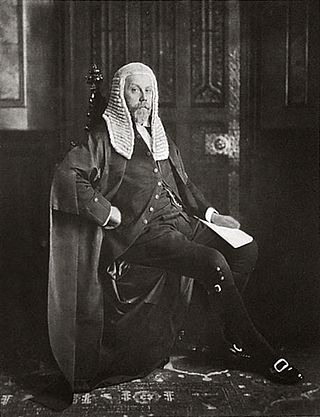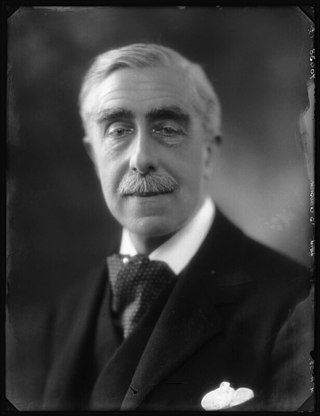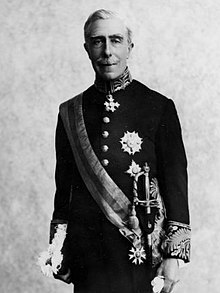
Marquess of Normanby is a title that has been created twice, once in the Peerage of England and once in the Peerage of the United Kingdom. The first creation came in 1694 in the Peerage of England in favour of John Sheffield, 3rd Earl of Mulgrave. He was a notable Tory politician of the late Stuart period, who served under Queen Anne as Lord Privy Seal and Lord President of the Council. In 1703 this first Marquess of Normanby was further honoured when he was made Duke of Buckingham and Normanby. These titles became extinct on the death of the 2nd Duke in 1735.

Marquess of Headfort is a title in the Peerage of Ireland. It was created in 1800 for Thomas Taylour, 2nd Earl of Bective.

Marquess of Cholmondeley is a title in the Peerage of the United Kingdom. It was created in 1815 for George Cholmondeley, 4th Earl of Cholmondeley.

Baron FitzWalter is an ancient title in the Peerage of England. It was created on 24 June 1295 for Robert FitzWalter. The title was created by writ, which means that it can descend through both male and female lines.

Earl Bathurst, of Bathurst in the County of Sussex, is a title in the Peerage of Great Britain.
Earl Fortescue is a title in the Peerage of Great Britain that was created in 1789 for Hugh Fortescue, 3rd Baron Fortescue (1753–1841), a member of parliament for Beaumaris and Lord-Lieutenant of Devon.
Earl of Swinton is a title in the Peerage of the United Kingdom. It was created in 1955 for the prominent Conservative politician Philip Cunliffe-Lister, 1st Viscount Swinton. He had already been created Viscount Swinton, of Masham in the County of York, in 1935, and was made Baron Masham, of Ellington in the County of York, at the same time he was given the earldom. Born Philip Lloyd-Greame, he was the husband of Mary Constance "Molly" Boynton, granddaughter of Samuel Cunliffe-Lister, 1st Baron Masham. When his wife inherited the large Masham estates in 1924, they assumed the surname of Cunliffe-Lister in lieu of Lloyd-Greame.

Earl of Granard is a title in the Peerage of Ireland. It was created in 1684 for Arthur Forbes, 1st Viscount Granard. He was a lieutenant-general in the army and served as Marshal of the Army in Ireland after the Restoration and was later Lord Justice of Ireland. He had already succeeded his father as second Baronet of Castle Forbes and been created Baron Clanehugh and Viscount Granard in 1675, also in the Peerage of Ireland. The baronetcy, of Castle Forbes in county Longford, was created in the Baronetage of Nova Scotia on 29 September 1628 for his father, Arthur Forbes.

Earl of Lonsdale is a title that has been created twice in British history, firstly in the Peerage of Great Britain in 1784, and then in the Peerage of the United Kingdom in 1807, both times for members of the Lowther family.

Earl of Rosse is a title that has been created twice in the Peerage of Ireland, both times for the Parsons family. "Rosse" refers to New Ross in County Wexford.

Earl of Selborne, in the County of Southampton, is a title in the Peerage of the United Kingdom. It was created in 1882 for the lawyer and Liberal politician Roundell Palmer, 1st Baron Selborne, along with the subsidiary title of Viscount Wolmer, of Blackmoor in the County of Southampton. He had already been made Baron Selborne, of Selborne in the County of Southampton, in 1872, also in the Peerage of the United Kingdom. Both his son, the second Earl, and grandson, the third Earl, were prominent Liberal Unionist politicians. The latter was in 1941 called to the House of Lords through a writ of acceleration in his father's barony of Selborne. The third Earl's grandson, the fourth Earl, served as one of the ninety elected hereditary peers that remain in the House of Lords after the passing of the House of Lords Act 1999, and sat as a Conservative. As of 2021, the titles are held by the latter's son, the fifth earl, who succeeded his father in that year.

Earl St Aldwyn, of Coln St Aldwyn in the County of Gloucester, is a title in the Peerage of the United Kingdom. It was created in 1915 for the prominent Conservative politician Michael Hicks Beach, 1st Viscount St Aldwyn, known from 1854 to 1907 as Sir Michael Hicks Beach, 9th Baronet, of Beverston. He was Chancellor of the Exchequer from 1885 to 1886 and again from 1895 to 1902. Hicks Beach had already been created Viscount St Aldwyn, of Coln St Aldwyn in the County of Gloucester, in 1906, and was made Viscount Quenington, of Quenington in the County of Gloucester, at the same time he was given the earldom. Both titles are in the Peerage of the United Kingdom. He was succeeded by his grandson, the second Earl, the son of Michael Hicks Beach, Viscount Quenington, Member of Parliament for Tewkesbury, who was killed in action in 1916. Lord St Aldwyn was also a Conservative politician and was Captain of the Honourable Corps of Gentlemen-at-Arms between 1958 and 1964 and 1970 and 1974. As of 2018 the titles are held by his eldest son, the third Earl, who succeeded in 1992.

Viscount Hawarden is a title in the Peerage of Ireland.

Viscount Ullswater, of Campsea Ashe in the County of Suffolk, is a title in the Peerage of the United Kingdom. It was created in 1921 for James Lowther upon his retirement as Speaker of the House of Commons. He was the eldest son of the Hon. William Lowther, third son of the Hon. Henry Lowther, second son of William Lowther, 1st Earl of Lonsdale. The first Viscount lived to the age of 93, and was pre-deceased by both his eldest son the Hon. Christopher Lowther, a Conservative politician, and his eldest son's eldest son John Arthur Lowther (1910–1942), the title being inherited by his seven-year-old great-grandson, the second and current Viscount, in an extremely rare instance of a great-grandson succeeding his great-grandfather in a peerage. The second Viscount held office in the Conservative administrations of Margaret Thatcher and John Major and since 2003 he has been one of the ninety elected hereditary peers that remain in the House of Lords after the passing of the House of Lords Act 1999.

Viscount Scarsdale, of Scarsdale in Derbyshire, is a title in the Peerage of the United Kingdom. It was created in 1911 for the prominent Conservative politician and former Viceroy of India George Curzon, 1st Baron Curzon of Kedleston, who was created Earl Curzon of Kedleston at the same time and was later made Marquess Curzon of Kedleston.
Charles Bathurst PC, known as Charles Bragge from 1754 to 1804, was a British politician of the early 19th century.

Charles Bathurst, 1st Viscount Bledisloe, was a British Conservative politician and colonial governor. He was Governor-General of New Zealand from 1930 to 1935.

Christopher Hiley Ludlow Bathurst, 3rd Viscount Bledisloe, QC, was a British barrister and politician.
Benjamin Ludlow Bathurst, 2nd Viscount Bledisloe, QC, was a British barrister.

Earl of Arran is a title in the Peerage of Ireland. It is not to be confused with the title Earl of Arran in the Peerage of Scotland. The two titles refer to different places: the Aran Islands in Ireland, and the Isle of Arran in Scotland. The Irish earldom is held by the Gore family. The Scottish earldom is a separate title, held as a subsidiary title of the Duke of Hamilton.












